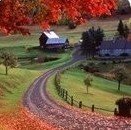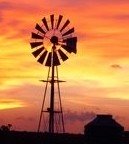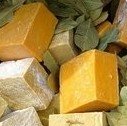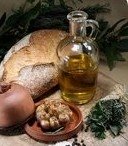Farming Memories Part 1 a
by K. Kraft.
(Ontario)
A Year on the Farm - Time
A day, a week, a month, a year, time to sow and time to reap, a time to store away the bounty of the earth and a time to rest. Never enough time to rest. What type of job requires 100% investment, no days off and the time of year with the best weather is also the busiest?
To put seeds in the ground and hope that they will germinate and that there will be sufficient moisture to sustain them. The weather for the season will not be to wet but not to dry, not to hot but not to cool either. Planting crops is an investment. It's no different than putting your money into the stock market. Sometime your stock rises and some times it doesn't. But like the stock market it's the knowledgeable investors that stand to profit most. That late summer storms don't pound the crop flat with hail. To tend livestock, protecting them from predators.
The Bible is full of practical tips on farming. I guess Jesus knew who he was talking to in his parables, the analogies of the day. What drives someone to get into this way of life? I call it a way of life as opposed to a profession because one can change professions/jobs much easier than anyone can get in or out of farming.
Family farms, sometimes the title came straight from the crown. Tough stuff to walk away from. Hobby farms, country property. City folks wanting to get out of the rat race. Anyone remember the "Back to Landers" from the seventies? Harrowsmith magazine catered to the yearning of so many souls to be free from the city. Grow your own food, reduced footprint, watching your kids run outside free of concern for bullies and gangs. Fresh air and blue sky.
The same philosophies are still in play today. Too bad that it took thirty years for the technology to catch up so that people can telecommute. So many different ways to get involved with this way of life.
There was a time when farming was less about making money and more about sustaining life. This is not to say money was unimportant because bills had to be paid and mortgages needed to be serviced but it there was a living to be found on the farm that was separate from pure monetary gain.
I don't yet consider myself old but there has been a lot of change in agriculture in my lifetime. Not long ago the practice of mixed farming meaning having different types of animals and crops on one farm was the norm. Pigs, cattle, chickens, ducks, rabbits, sheep and horses all came and went on our farm. We grew corn, wheat, oats, barley and root crops. "Root crops" now there is a couple words that you won't hear to often anymore, but more of these later.
The mix of animals and crops and a large garden went a long way to ensuring that no one disease, blight or run of bad weather was going to take away the ability to sustain one's life or livelihood.
Large families ensured a quantity of backs and hands when work needed to get done. When farm families did not own all the equipment to get the years work done then they would help neighbors with what they had and in return the required equipment would arrive so everyone's crops got harvested in a timely manner.
Time for Maple Syrup
The sun in late February feels warm on your face. The days are getting longer and the wind is out of the south for a change. The first task one can set one's self to after the cold of winter starts to fade is tapping the maple trees for sap with is made into maple syrup.
The accumulation of snow is the bush is the secret of the whole maple season. As the days get longer and the temperatures rise above freezing the snow starts to melt and this available moisture is absorbed by the maple tree's roots and made into sap to nourish the tree.
Tapping the tree to release some of this sugary fluid is something that the natives taught the first white folks to do and we were still doing it when I was a kid. Drill a small hole in the tree, tap in a short tube. called a spile, to direct the sap out of the tree into a pail. The spile has a hook on it that the pail hangs on. Repeat this procedure 100 times. Considering the depth of the snow in the bush at the time of tapping would be between 2 to 4 feet this was heavy going to lug stacks of pails, a bucket of spiles and a hand cranked brace and bit ( hand drill ).
Bucking through the snow to get the old Massey tractor back to the bush was a day long job in itself. Driving a few feet into the deep snow till the the wheels spin and backing up to do it again and again to gain a few more feet.
Good thing gas was cheap back then. You see you needed a tractor back at the bush to gather the sap which is too heavy to lug by hand, more than a short distance. A tractor with a nice slow, low gear to minimize sloshing and spillage while driving through the bush paths that are not straight or level.
I can recall a few times when the sap barrel on the tractor got close to full and a lurch of the tractor cause a wave of sap to leap onto the drivers head. I guess cold sap didn't feel too good going down the back of the neck but man it sure put out a cigarette in a hurry.
Back in the mid seventies we built a log cabin in the bush to make maple syrup. We cut down poplar trees and dried them for a year. Cut them to length and notched them to fit together. Tamarack poles cut from our bush were the rafters. Our hemlock trees cut at the local mill for the strapping. The only parts that we bought were the steel for the roof and the nails to hold it on.
Syrup making, like so many other human activities, was more enjoyable indoors, especially in February, March and the early part of April. The daily trips to the bush to gather sap or feed the fire were done by snowmobile. A little quicker than the tractor and more fun too.
Inside the cabin there was a large fireplace on which a large pan sat. This pan would be 3 feet wide by 6 feet long and 8 inches deep. The sap from the trees went into said pan and a large and hearty fire would be lit under it. As the sap boiled the water would steam off increasing the sugar content. More sap more fire and eventually one would have a lot of maple syrup.
Things to look out for! Cold snaps caused the trees to stop dripping sap. Rainy weather means pails on trees need to be dumped. Walking with pails of sap over uneven ground can cause freezing cold sap to splash into your rubber boots, a sensation that one remembers forever. Too much fire and not enough sap can cause syrup to burn in pan, big mess don't go there.
Good points! Watching as the dog sleeps on a carpet of last years leaves after the snow has melted and the sun shining down. First chance to get out of the house after winter.
Spreading Manure
Weather turns warm. Snow is gone and a break from spring rain gives one a chance to get on the land. Spreading manure that has accumulated in the barnyard over the winter is the next job.
When everyone in the area is spreading manure it can be said that spring is indeed in the air. Preparing the soil and planting the crops is the next matter at hand. Hopefully you got your plowing done last fall and all that is needed is to run a cultivator or disc or both over the field to be planted. This produces a suitable bed for the seeds to sprout and grow. The seed companies will have you believe that every year you need their newest and best product and that by simply writing a large cheque they will ensure your success.
We found that by employing a rather ancient device known as a fanning mill we could use some of the seed from last years crop to plant in the fields thereby ensuring our own success and saving writing that cheque.
Now a fanning mill separates the good seeds (likely to germinate) from the bad seeds (not likely to germinate, better for cattle feed) by a fanning and screening process. The fanning mill gets its name from the large fan inside that blows the light seeds away as the grain falls inside. These machines were originally human powered by cranking a handle. Ours had a 1/4 horse power motor that probably came from a old washing machine. The screens separate the right sized seeds from the others. The good seeds end up in a pile at end of the machine. They are bagged and are ready to be sown in the field.
Things to look out for! These old machines have no machinery guards but they do have open gear and chain drives. Ever wonder why so many old guys walk around with fingers missing? Good points! Nice job for winter when not much else is happening.
Picking stones is a job that gets done after the seed is in the ground. Hook a wagon on the back of a tractor and drive around picking up rocks and placing them on the trailer. It is done to protect the farm equipment from picking up stones and trying to process them. This can do a lot of damage. Each year a new crop of stones comes up through frost and working the ground. Anyway you slice it picking stones is not fun but it has to be done.
Cutting Firewood
Between seeding and haying was when we used to bring in the firewood for the season. I used to think this was the stupidest thing as everyone knew that you didn't need firewood till next winter why waste such beautiful days cutting wood. It just didn't make sense to me but because our farm ran with a chain of command and I was nowhere near the top we did firewood between seeding and haying.
Cutting trees in the bush, skidding them out with a tractor, blocking the wood with a chainsaw and spitting it with an axe or in later years we had a hydraulic wood splitter that ran off the tractor. Saved swinging the axe! Then gathering up the pieces of wood placing them on a wagon.
Pulling said wagon with said tractor to the woodshed beside the house, and piling the wood in neat rows for use in the winter. So much is done in preparation for winter, it makes me tired just thinking about it. ... to be continued.
Did you find this page helpful?
Sharing is a way of saying, "Thanks!"
Follow Us and Keep Up to Date
Go back to the Home Page





